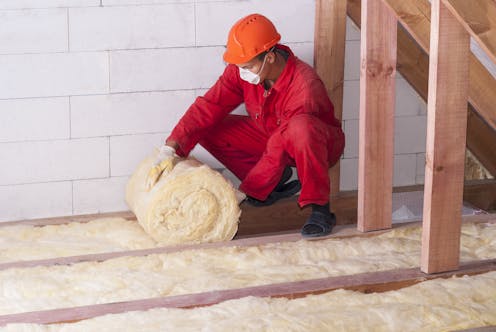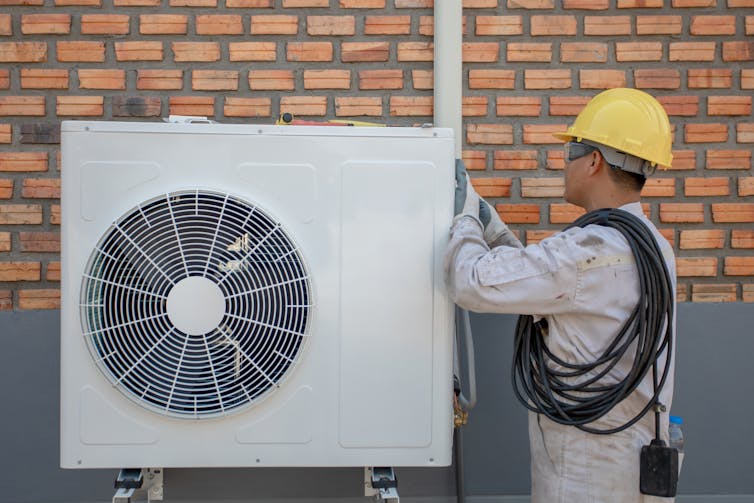
The UK is failing to enact the policies that would put it on track to reach net zero emissions by 2050, according to a progress report by the Climate Change Committee. The head of this expert body, which advises the government on its climate strategy, described the UK’s record on home insulation in particular as “a complete tale of woe”.
Gas heating in draughty homes is one of the country’s biggest sources of carbon emissions – and a leading cause of poor health and poverty as energy prices remain sky-high. So what would it take to turn this around?

Don’t have time to read about climate change as much as you’d like?
Get a weekly roundup in your inbox instead. Every Wednesday, The Conversation’s environment editor writes Imagine, a short email that goes a little deeper into just one climate issue. Join the 10,000+ readers who’ve subscribed so far.
“The transition to net zero emissions is often framed as a race to make new stuff – such as electric vehicles and wind turbines – as fast as possible,” says Ran Boydell, a visiting lecturer in sustainable development at Heriot-Watt University.
“That’s actually the easy part. The hard part will be modifying what already exists – and that includes people’s homes.”
Cavity wall insulation, triple-glazed windows, solar panels, low-carbon heating systems such as heat pumps which run on electricity: all of these things and potentially more are needed to neutralise the contributions to climate change made by 26 million homes (the number of existing homes Boydell anticipates will still be around in 2050). That would eliminate 68 million tonnes of CO₂, which is about 15% of the national total.
“The idea is to ensure that no home emits greenhouse gases by burning fossil fuels for energy and that, eventually, each home could produce as much energy as it uses,” Boydell says.
According to analysis by the Climate Change Committee, the average cost of retrofitting a single home to net zero standard is £26,000. Energy savings would make up for this after 20 years, but most households would struggle to make such a big upfront investment.
“Considering energy efficiency measures purely in terms of financial payback will never stack up,” Boydell says. “They must be considered in terms of carbon payback. Carbon payback is how quickly the reduced carbon emissions from daily life in a net zero home take to make up for the carbon emissions that went into making and building all the different parts.”
A home operating at net zero standard would compensate for the carbon that went into building it after just six years, Boydell estimates. But it’s the responsibility of the government – and not individual homeowners – to juggle these considerations, he says.
“Infrastructure, like roads and railways, is the only stuff people build which counts its payback periods in decades. The government needs to think of a mass retrofit programme for our houses in those terms: as critical national infrastructure.”
Fund, regulate and overhaul
Matthew Hannon and Donal Brown study green policy at the universities of Strathclyde and Sussex. They say that:
“At an absolute minimum, the government should be aiming to install insulation in 1.3 million homes a year – a rate it managed pre-2013.”
To reach that level, Hannon and Brown have four suggestions. First, increase annual funding for retrofitting homes from £1 billion to £7 billion – enough to retrofit 7 million homes by 2025, they claim. Next, shift the burden of raising this money into general taxation and away from energy bill levies which strain the poorest households and inflate the cost of heating homes with zero-carbon electricity.
“Insulating hundreds of homes at a time, neighbourhood by neighbourhood and coordinated by local authorities, could help to retrofit housing deeper and faster than tackling homes one by one,” they say. For this, collaboration with local groups and businesses who know the community well will be key. Hannon and Brown argue the government will also need a separate, well-funded programme to install heat pumps and other low-carbon heating systems, while phasing out support for gas boilers.

Once a national campaign to renovate Britain’s homes to net zero standard is underway, there are certain to be teething problems. The Labour Party offered a comprehensive programme of home insulation at the 2019 election. At the time, Jo Richardson, a professor of housing and social inclusion at De Montfort University, and David Coley, a professor of low-carbon design at the University of Bath, described the obstacles that will need to be overcome.
“The UK construction sector is highly fragmented – and different subcontractors are often responsible for the walls, roof and electricity in a single house. This makes quality control difficult. There’s also a skills shortage, especially when it comes to the detailed knowledge required to build a zero-energy house. And if energy-consuming extras such as underfloor heating or electrically driven windows are added, the energy savings from design may be lost,” they say.
The Climate Change Committee noted that new homes are rarely net zero standard, with 1.5 million built in recent years that will need to be retrofitted. The preferred solution for Richardson and Coley is to mandate each new home to Passivhaus standard, which certifies that it produces as much energy as it uses.
“Passivhaus only works if the right design decisions are made from day one,” they caution. “If an architect starts by drawing a large window for example, then the energy loss from it might well be so great that any amount of insulation elsewhere can’t offset it. Architects don’t often welcome this intrusion of physics into the world of art.”
Increased funding, new regulations and an overhaul of architectural norms will be necessary to roll out zero-energy homes and retrofit existing ones. “That’s a tall order,” say Richardson and Coley. “But decarbonising each component of society will take nothing short of a revolution.”
This article was originally published on The Conversation. Read the original article.







